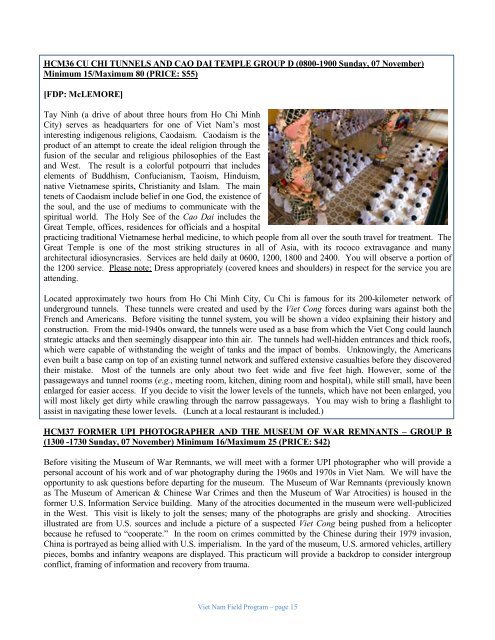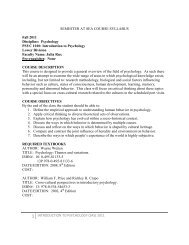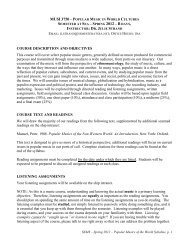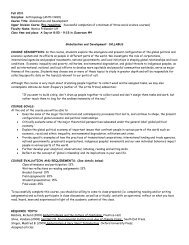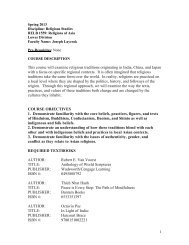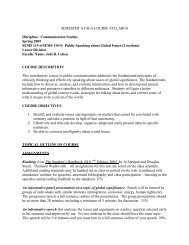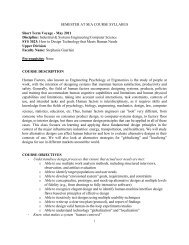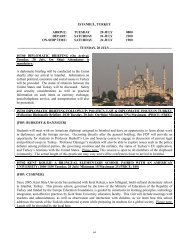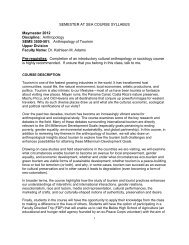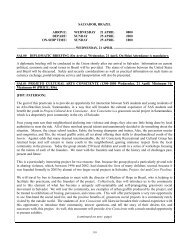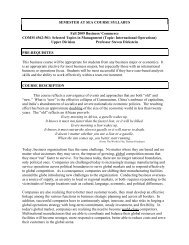Final Field Program - University of Virginia
Final Field Program - University of Virginia
Final Field Program - University of Virginia
You also want an ePaper? Increase the reach of your titles
YUMPU automatically turns print PDFs into web optimized ePapers that Google loves.
HCM36 CU CHI TUNNELS AND CAO DAI TEMPLE GROUP D (0800-1900 Sunday, 07 November)<br />
Minimum 15/Maximum 80 (PRICE: $55)<br />
[FDP: McLEMORE]<br />
Tay Ninh (a drive <strong>of</strong> about three hours from Ho Chi Minh<br />
City) serves as headquarters for one <strong>of</strong> Viet Nam’s most<br />
interesting indigenous religions, Caodaism. Caodaism is the<br />
product <strong>of</strong> an attempt to create the ideal religion through the<br />
fusion <strong>of</strong> the secular and religious philosophies <strong>of</strong> the East<br />
and West. The result is a colorful potpourri that includes<br />
elements <strong>of</strong> Buddhism, Confucianism, Taoism, Hinduism,<br />
native Vietnamese spirits, Christianity and Islam. The main<br />
tenets <strong>of</strong> Caodaism include belief in one God, the existence <strong>of</strong><br />
the soul, and the use <strong>of</strong> mediums to communicate with the<br />
spiritual world. The Holy See <strong>of</strong> the Cao Dai includes the<br />
Great Temple, <strong>of</strong>fices, residences for <strong>of</strong>ficials and a hospital<br />
practicing traditional Vietnamese herbal medicine, to which people from all over the south travel for treatment. The<br />
Great Temple is one <strong>of</strong> the most striking structures in all <strong>of</strong> Asia, with its rococo extravagance and many<br />
architectural idiosyncrasies. Services are held daily at 0600, 1200, 1800 and 2400. You will observe a portion <strong>of</strong><br />
the 1200 service. Please note: Dress appropriately (covered knees and shoulders) in respect for the service you are<br />
attending.<br />
Located approximately two hours from Ho Chi Minh City, Cu Chi is famous for its 200-kilometer network <strong>of</strong><br />
underground tunnels. These tunnels were created and used by the Viet Cong forces during wars against both the<br />
French and Americans. Before visiting the tunnel system, you will be shown a video explaining their history and<br />
construction. From the mid-1940s onward, the tunnels were used as a base from which the Viet Cong could launch<br />
strategic attacks and then seemingly disappear into thin air. The tunnels had well-hidden entrances and thick ro<strong>of</strong>s,<br />
which were capable <strong>of</strong> withstanding the weight <strong>of</strong> tanks and the impact <strong>of</strong> bombs. Unknowingly, the Americans<br />
even built a base camp on top <strong>of</strong> an existing tunnel network and suffered extensive casualties before they discovered<br />
their mistake. Most <strong>of</strong> the tunnels are only about two feet wide and five feet high. However, some <strong>of</strong> the<br />
passageways and tunnel rooms (e.g., meeting room, kitchen, dining room and hospital), while still small, have been<br />
enlarged for easier access. If you decide to visit the lower levels <strong>of</strong> the tunnels, which have not been enlarged, you<br />
will most likely get dirty while crawling through the narrow passageways. You may wish to bring a flashlight to<br />
assist in navigating these lower levels. (Lunch at a local restaurant is included.)<br />
HCM37 FORMER UPI PHOTOGRAPHER AND THE MUSEUM OF WAR REMNANTS – GROUP B<br />
(1300 -1730 Sunday, 07 November) Minimum 16/Maximum 25 (PRICE: $42)<br />
Before visiting the Museum <strong>of</strong> War Remnants, we will meet with a former UPI photographer who will provide a<br />
personal account <strong>of</strong> his work and <strong>of</strong> war photography during the 1960s and 1970s in Viet Nam. We will have the<br />
opportunity to ask questions before departing for the museum. The Museum <strong>of</strong> War Remnants (previously known<br />
as The Museum <strong>of</strong> American & Chinese War Crimes and then the Museum <strong>of</strong> War Atrocities) is housed in the<br />
former U.S. Information Service building. Many <strong>of</strong> the atrocities documented in the museum were well-publicized<br />
in the West. This visit is likely to jolt the senses; many <strong>of</strong> the photographs are grisly and shocking. Atrocities<br />
illustrated are from U.S. sources and include a picture <strong>of</strong> a suspected Viet Cong being pushed from a helicopter<br />
because he refused to “cooperate.” In the room on crimes committed by the Chinese during their 1979 invasion,<br />
China is portrayed as being allied with U.S. imperialism. In the yard <strong>of</strong> the museum, U.S. armored vehicles, artillery<br />
pieces, bombs and infantry weapons are displayed. This practicum will provide a backdrop to consider intergroup<br />
conflict, framing <strong>of</strong> information and recovery from trauma.<br />
Viet Nam <strong>Field</strong> <strong>Program</strong> – page 15


